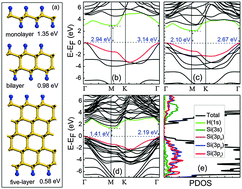A strain or electric field induced direct bandgap in ultrathin silicon film and its application in photovoltaics or photocatalysis†
Abstract
The indirect bandgap character of silicon greatly limits its applications in electronic or optoelectronic devices, and direct bandgaps are highly desirable in all silicon allotropes. The successful synthesis of ultrathin or even monolayer silicon films experimentally has opened new opportunities to further modulate the electronic structure of silicon through external modulation. In this work, strain or electric field effects on the electronic structure of ultrathin silicon film (USF) are systematically explored. The results demonstrate that all USFs are indirect band-gap semiconductors; interestingly, tensile strain or electric field efficiently tunes the USFs into direct band gap semiconductors. The indirect to direct band gap transition in the USFs not only extends their light adsorption spectra into the visible light region but also greatly enhances the adsorption intensity. Because of this, strained USFs have great potential to be used as a high-performance photovoltaic material. Furthermore, the high stability, moderate band-gap and proper band edge positions demonstrate that monolayer and bilayer USFs can also be used as photocatalysts for water splitting.


 Please wait while we load your content...
Please wait while we load your content...